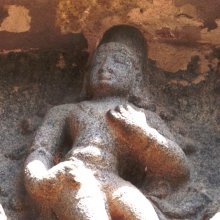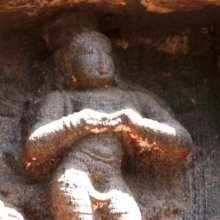Vartita: 7 definitions
Introduction:
Vartita means something in Hinduism, Sanskrit, Hindi. If you want to know the exact meaning, history, etymology or English translation of this term then check out the descriptions on this page. Add your comment or reference to a book if you want to contribute to this summary article.
Alternative spellings of this word include Vartit.
Images (photo gallery)
In Hinduism
Natyashastra (theatrics and dramaturgy)
Source: Wisdom Library: Nāṭya-śāstraVartita (वर्तित).—One of the 108 karaṇas (minor dance movement) mentioned in the Nāṭyaśāstra chapter 4. The instructions for this vartita-karaṇa is as follows, “Vyavṛtta(= Vyavartita) and Parivartita hands bent at the wrist, then these hands placed on thighs.”.
A karaṇa represents a minor dance movements and combines sthāna (standing position), cārī (foot and leg movement) and nṛttahasta (hands in dancing position).

Natyashastra (नाट्यशास्त्र, nāṭyaśāstra) refers to both the ancient Indian tradition (shastra) of performing arts, (natya—theatrics, drama, dance, music), as well as the name of a Sanskrit work dealing with these subjects. It also teaches the rules for composing Dramatic plays (nataka), construction and performance of Theater, and Poetic works (kavya).
Languages of India and abroad
Sanskrit dictionary
Source: DDSA: The practical Sanskrit-English dictionaryVartita (वर्तित).—a.
1) Turned, rolled.
2) Caused to be or exist.
3) Brought about, accomplished.
4) Spent, passed (as time or life).
Source: Cologne Digital Sanskrit Dictionaries: Edgerton Buddhist Hybrid Sanskrit DictionaryVartita (वर्तित).—ppp. (see s.v. vartanā-veṇī), beaded, i.e. made of beads (compare Sanskrit varti, to which this might be denom.; or it may be from Sanskrit vartayati, rolls, hence rolled, made into balls); in any case associated with vartanā-(veṇī): udarāc ca pṛṣṭhivaṃśo vidṛśyate vartitā yathā veṇī Lalitavistara 260.2 (verse), like a beaded string (string of beads).
Source: Cologne Digital Sanskrit Dictionaries: Monier-Williams Sanskrit-English Dictionary1) Vartitā (वर्तिता):—[=varti-tā] [from varti > varta] f. (ifc.) conduct or behaviour towards, [Rāmāyaṇa]
2) Vartita (वर्तित):—[from varta] mfn. ([from] [Causal]) turned, rounded (See su-v)
3) [v.s. ...] turned about, rolled (as a wheel), [Bhāgavata-purāṇa]
4) [v.s. ...] caused to be or exist, brought about, accomplished, prepared, [Mahābhārata; Pañcatantra]
5) [v.s. ...] spent, passed (as time or life), [Mahābhārata; Bhāgavata-purāṇa]
[Sanskrit to German]
Sanskrit, also spelled संस्कृतम् (saṃskṛtam), is an ancient language of India commonly seen as the grandmother of the Indo-European language family (even English!). Closely allied with Prakrit and Pali, Sanskrit is more exhaustive in both grammar and terms and has the most extensive collection of literature in the world, greatly surpassing its sister-languages Greek and Latin.
Hindi dictionary
Source: DDSA: A practical Hindi-English dictionaryVartita (वर्तित) [Also spelled vartit]:—(a) set in rotation or motion; done; past.
...
Nepali dictionary
Source: unoes: Nepali-English DictionaryVartita (वर्तित):—adj. 1. turned; revolved; 2. spent; past;
Nepali is the primary language of the Nepalese people counting almost 20 million native speakers. The country of Nepal is situated in the Himalaya mountain range to the north of India.
See also (Relevant definitions)
Starts with: Vartitajanman, Vartitaka, Vartitartha, Vartitavat, Vartitavya.
Query error!
Full-text (+21): Parivartita, Avartita, Vivartita, Paryavartita, Samvartita, Nivartita, Suvartita, Apavartita, Vartitajanman, Udvartita, Ekacakravartin, Vartit, Parivartana, Vartitavat, Anupravartita, Samasamayavartita, Purvavartita, Guruvartita, Mahacakravartita, Cakravartita.
Relevant text
Search found 8 books and stories containing Vartita, Varti-ta, Varti-tā, Vartitā; (plurals include: Vartitas, tas, tās, Vartitās). You can also click to the full overview containing English textual excerpts. Below are direct links for the most relevant articles:
Bhakti-rasamrta-sindhu (by Śrīla Rūpa Gosvāmī)
Verse 1.2.115 < [Part 2 - Devotional Service in Practice (sādhana-bhakti)]
Verse 1.2.82 < [Part 2 - Devotional Service in Practice (sādhana-bhakti)]
Gati in Theory and Practice (by Dr. Sujatha Mohan)
Gati in Kāma-avasthās < [Chapter 3 - Application of gati in Dṛśya-kāvyas]
Elucidation of Karaṇas related to Gati < [Chapter 2 - Concept and technique of Gati]
Analysis of technical terms: Nāṭya, Nṛtta, Nṛtya < [Chapter 1 - Nāṭya]
A History of Indian Philosophy Volume 3 (by Surendranath Dasgupta)
Part 22 - Raṅgācārya < [Chapter XX - Philosophy of the Rāmānuja School of Thought]
Hastalaksanadipika a critical edition and study (by E. K. Sudha)
11. The built up Sequence in Stage business < [Chapter 2 - Bharata’s Dramaturgy]
The Sun-Worshipping Sakadvipiya Brahmanas (by Martina Palladino)
1. Sanskrit text < [Chapter 1 - The Purāṇic Sections]
Abhijnana Sakuntala (with Katayavema commentary) (by C. Sankara Rama Sastri)
Chapter 5 - Sanskrit text (pancama-anka) < [Abhijnana Sakuntalam, text and commentary]
Chapter 7 - Notes and Analysis of Seventh Act < [Abhijnana Sakuntalam, text and commentary]

